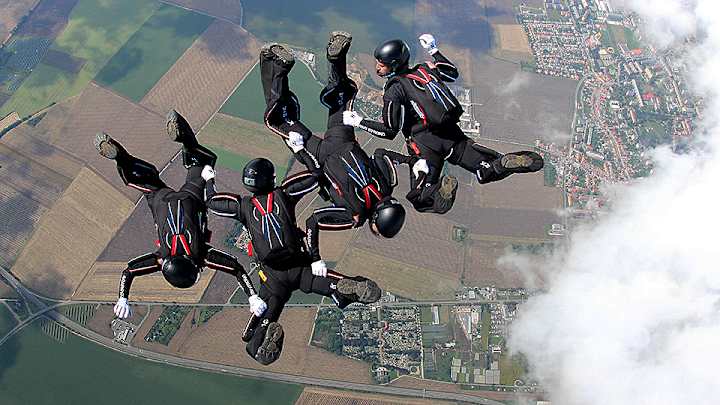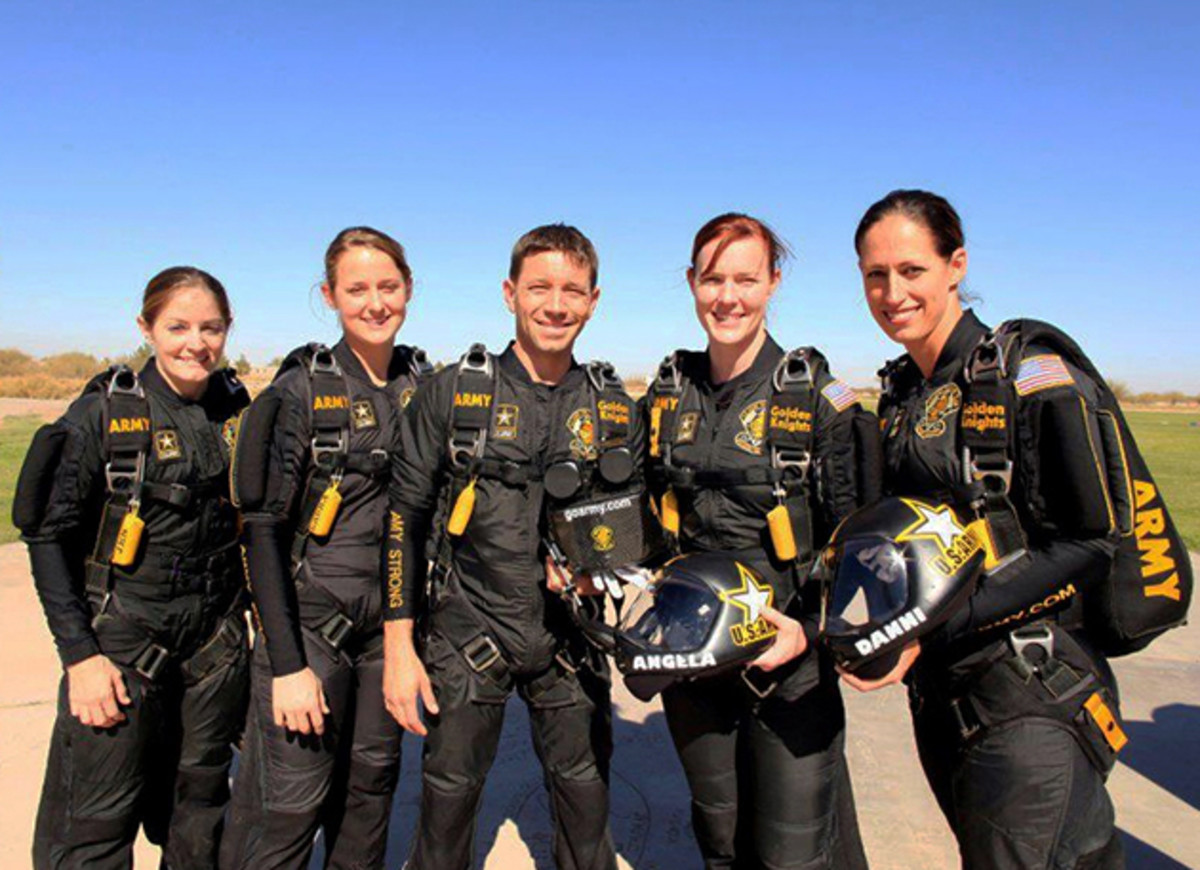Golden Knights' female-only skydiving squad deserves respect

For many people, falling through the sky at 120 mph would sound like a nightmare. For Angela Nichols it sounds like a routine day at the office.
That’s because the 38-year-old sergeant from Rowlett, Texas, is the team leader of the U.S. Army Parachute Division’s Female Four-Way Skydiving Competition Team.
"It’s intense and a bit of sensory overload," Nichols says while explaining her airborne exploits. "But after you’ve had some practice you get more comfortable."
She’s had plenty of practice. Nichols made her first jump when she turned 18—a birthday present from her father, Charles, who had taken up the sport a year earlier.
"When I touched the ground the first thing I asked my dad was, ‘When can we do it next?’" Nichols says.
She was hooked. On her 19th birthday Nichols and her father each made their 100th jump together.
Skydiving’s transformation from recreation to vocation started the day Nichols first caught sight of the Army’s parachute team, the Golden Knights, when they visited her local drop zone outside of Rowlett. "I was in awe," Nichols admits.
She wasn’t a spectator for long. One year after she enlisted and had completed training as a medical specialist, Nichols volunteered for the Golden Knights’ Assessment and Selection program in the fall of 1999. But acceptance was hardly a guarantee. Only a quarter of applicants make it through GKAS at Fort Bragg, N.C. Nichols endured the 4 a.m. wake up calls followed by predawn physical training, the countless hours of rehearsing safety procedures, and up to 20 jumps a day to achieve ‘knighted’ status and earn her first assignment in 2000.
That was just the start.
Nichols estimates that, during her three assignments and 14 seasons with the Golden Knights, she has made between 13,000 to 13,500 jumps—more than double the total of any of her teammates.
“I’ve been pretty busy,” says Nichols, who also completed a 10-month deployment to Iraq in 2009.
The airtime has paid off. Since Nichols’ assignment to the Female Four-Way Competition team (GKF4) in 2010, the team has traveled to events as far away as Indonesia and Qatar and brought home enough medals to fill a hangar.
During competition, teams have 35 seconds to perform a series of formations, such as a diamond, or a boomerang, from a random sequence. The team is also judged on the accuracy of their handholds, their shape, and their transitions between the formations (which include spins and barrel rolls). Sgt. 1st Class Scott Janise, the Golden Knights’ free-fall videographer, makes every jump with the team and records each one for the judges to review.
This year Nichols, along with Sgt. 1st Class Laura Dickmeyer, Sgt. 1st Class Dannielle Woosley and Sgt. 1st Class Jennifer Davidson, won 18 medals between the sport’s two largest events: the World Championships in the Czech Republic and the U.S. Parachute Association nationals in Chicago.

Adding to the impressive résumé is that GKF4 is the only four-way all-female team that participates in the Open division.
“When we first started competing around the country there was definitely a bit of surprise,” says Sgt. 1st Class Laura Espinosa, the team’s alternate. “A lot of times people’s reactions were, ‘Wow, I didn’t know girls could do that.’”
They can. At nationals in September, GKF4 took the bronze medal in the Open Division, and their 29-point total set both national and Illinois state records for the most points in a round by an all-female four-way freestyle team.
But their success isn’t a windfall. “It’s our camaraderie and all of our practice that makes the difference,” Nichols says.
Just look at their schedule. During training season, GKF4 performs between 10 to 15 jumps a day at the airfield outside of Fort Bragg, then debriefs and analyzes SFC Janise’s video like a football team breaking down game film.
By 4:00 p.m. the team heads home. Their work isn’t done. "Each dive in competition is like a 35-second sprint," says Dickmeyer. "So cardio plays a huge role and we each have our own training regimen."
While Dickmeyer prefers Crossfit and yoga, Nichols opts for swimming or cycling. But the members of the team aren’t apart for long—spending upwards of 11 hours a day together.
A First-time Skydiving Experience, a Fall to Earth and a Terrible Accident
"We’re probably around each other more than we’re with our families," Nichols admits.
The connection is evident in the precision of the GKF4’s formations, when Nichols and her teammates communicate with a glance or slight hand motion. But you also notice that awareness on the ground. The team’s dialogue is as synchronized as their movements in the sky.
When fielding questions, Nichols takes the lead, then her teammates seamlessly enter the conversation.
"It’s more of a performance anxiety than a real fear," Nichols says when asked if she ever gets nervous before a jump.
"You don’t want to be the one to mess up," Dickmeyer continues.
"But after a while you begin to trust yourself and your teammates," Espinosa concludes. "With every jump you gain more and more confidence."
And that level of trust and camaraderie is why Nichols has no intention of slowing down during the last two years of her assignment with GKF4. She says there is no secret formula to her longevity; rather, it is her bond with the other sergeants and her “hard-headedness” to achieve her goals that keep her going. Maybe that competitive drive is why Nichols’s only injury during her skydiving career didn’t occur at 10,000 feet. She broke her pinkie finger playing volleyball.
